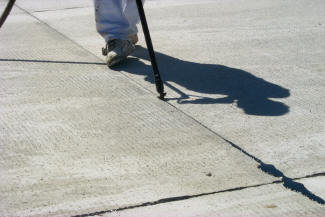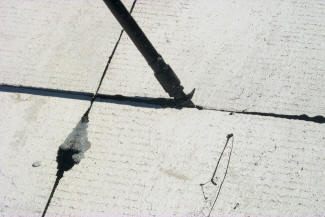Sealant products are used to fill joints (Figures 1 and 2) and cracks in order to prevent entry of water or other non-compressible substances. Although most PCC pavement joints are sealed at the time of new construction, the useful sealant life is limited as stated by the ACPA (2001[1]) on their web site:
“A typical hot-pour sealant provides an average of 3 to 5 years of life after proper installation. Some low-modulus or PVC coal-tars can perform well past 8 years. Silicone sealants have performed well for periods exceeding 8 to 10 years on roadways. This type of performance hinges on joint preparation and installation. Of extreme importance is that the joint be clean and dry. Compression seals provide service for periods often exceeding 15 years and sometimes 20 years.”
Crack sealant is typically used on early stage, isolated panel cracks; extensive or advanced panel cracking is a symptom of larger problem (e.g., lack of panel support, inadequate structural design or poor construction) that cannot be addressed by simple crack sealing.
Purpose
Preventive maintenance. Joint and crack filling to prevent entry of water or other non-compressible substances into the pavement.
Materials
Hot-pour seals, compression seals, silicone seals
Other Information
Sealant performance is dependent upon proper joint design and cleanliness.
- American Concrete Pavement Association (ACPA). (2001). Concrete Types.↵


